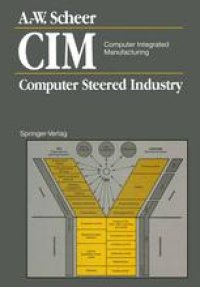
Ebook: CIM Computer Integrated Manufacturing: Computer Steered Industry
- Tags: Business Information Systems, Production/Logistics/Supply Chain Management, Manufacturing Machines Tools
- Year: 1988
- Publisher: Springer-Verlag Berlin Heidelberg
- Edition: 1
- Language: English
- pdf
Modern information technology has opened up new possibilities of flexibilization and cost reduction in production. The author defines CIM - Computer Integrated Manufacturing - as a concept for the structuring of industrial enterprises. Manufacturing technologies demand a CIM concept which can be realized through the capabilities of information processing available today. The idea of integrating different areas of CIM, such as production planning and control (PPC), computer aided design (CAD) and computer aided manufacturing (CAM), is explained through operating chains and put into a CIM architecture based on a hierarchy of EDP systems. The stance taken in this book of defining CIM as a total concept for industrial enterprises is increasingly gaining ground. The book does not aim to put the functional details of the individual CIM components (PPC, CAD, CAP and CAM) in the foreground, but rather to emphasize the integration principles for the functional demands of the individual components. This book appeared in the Federal Republic of Germany in 1987, and within one year it had run to three editions. The author contributes to this book not only his scientific knowledge but also his experience as a consultant for implementing CIM concepts.
Modern information technology has opened up new possibilities of flexibilization and cost reduction in production. The author defines CIM - Computer Integrated Manufacturing - as a concept for the structuring of industrial enterprises. Manufacturing technologies demand a CIM concept which can be realized through the capabilities of information processing available today. The idea of integrating different areas of CIM, such as production planning and control (PPC), computer aided design (CAD) and computer aided manufacturing (CAM), is explained through operating chains and put into a CIM architecture based on a hierarchy of EDP systems. The stance taken in this book of defining CIM as a total concept for industrial enterprises is increasingly gaining ground. The book does not aim to put the functional details of the individual CIM components (PPC, CAD, CAP and CAM) in the foreground, but rather to emphasize the integration principles for the functional demands of the individual components. This book appeared in the Federal Republic of Germany in 1987, and within one year it had run to three editions. The author contributes to this book not only his scientific knowledge but also his experience as a consultant for implementing CIM concepts.
Modern information technology has opened up new possibilities of flexibilization and cost reduction in production. The author defines CIM - Computer Integrated Manufacturing - as a concept for the structuring of industrial enterprises. Manufacturing technologies demand a CIM concept which can be realized through the capabilities of information processing available today. The idea of integrating different areas of CIM, such as production planning and control (PPC), computer aided design (CAD) and computer aided manufacturing (CAM), is explained through operating chains and put into a CIM architecture based on a hierarchy of EDP systems. The stance taken in this book of defining CIM as a total concept for industrial enterprises is increasingly gaining ground. The book does not aim to put the functional details of the individual CIM components (PPC, CAD, CAP and CAM) in the foreground, but rather to emphasize the integration principles for the functional demands of the individual components. This book appeared in the Federal Republic of Germany in 1987, and within one year it had run to three editions. The author contributes to this book not only his scientific knowledge but also his experience as a consultant for implementing CIM concepts.
Content:
Front Matter....Pages I-XI
Introduction....Pages 1-2
The Meaning of the “I” in CIM....Pages 3-15
The Components of CIM....Pages 17-62
Implementation of CIM....Pages 63-110
CIM Prototypes....Pages 111-147
Further CIM Developments....Pages 149-183
References....Pages 185-193
Back Matter....Pages 195-201
Modern information technology has opened up new possibilities of flexibilization and cost reduction in production. The author defines CIM - Computer Integrated Manufacturing - as a concept for the structuring of industrial enterprises. Manufacturing technologies demand a CIM concept which can be realized through the capabilities of information processing available today. The idea of integrating different areas of CIM, such as production planning and control (PPC), computer aided design (CAD) and computer aided manufacturing (CAM), is explained through operating chains and put into a CIM architecture based on a hierarchy of EDP systems. The stance taken in this book of defining CIM as a total concept for industrial enterprises is increasingly gaining ground. The book does not aim to put the functional details of the individual CIM components (PPC, CAD, CAP and CAM) in the foreground, but rather to emphasize the integration principles for the functional demands of the individual components. This book appeared in the Federal Republic of Germany in 1987, and within one year it had run to three editions. The author contributes to this book not only his scientific knowledge but also his experience as a consultant for implementing CIM concepts.
Content:
Front Matter....Pages I-XI
Introduction....Pages 1-2
The Meaning of the “I” in CIM....Pages 3-15
The Components of CIM....Pages 17-62
Implementation of CIM....Pages 63-110
CIM Prototypes....Pages 111-147
Further CIM Developments....Pages 149-183
References....Pages 185-193
Back Matter....Pages 195-201
....